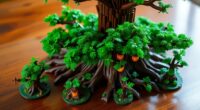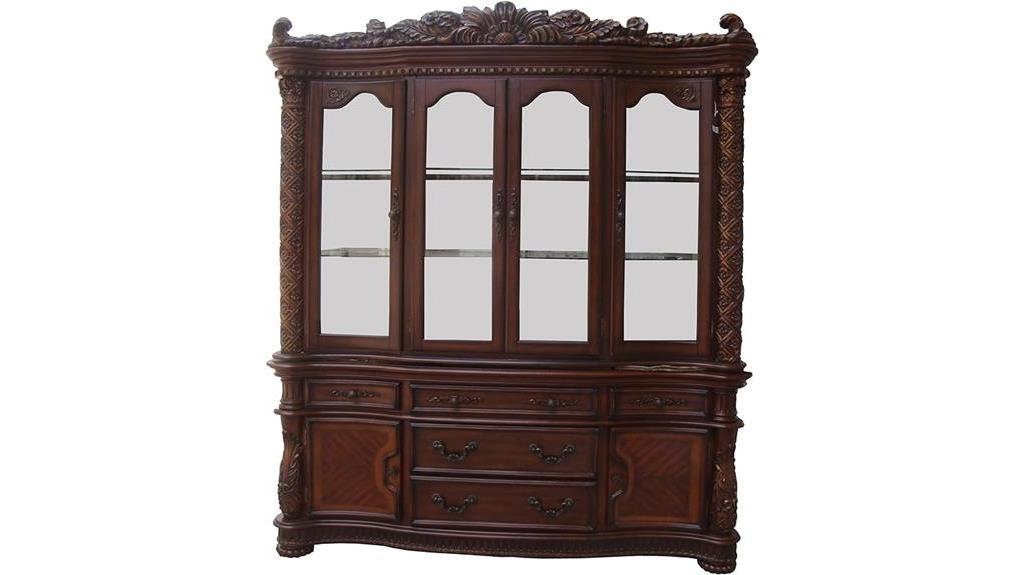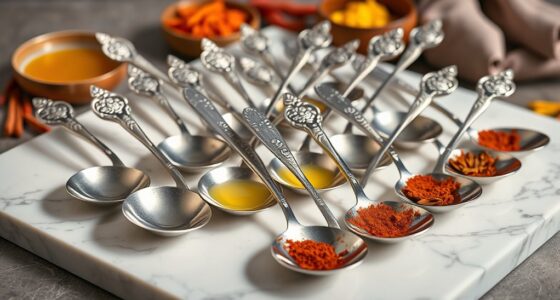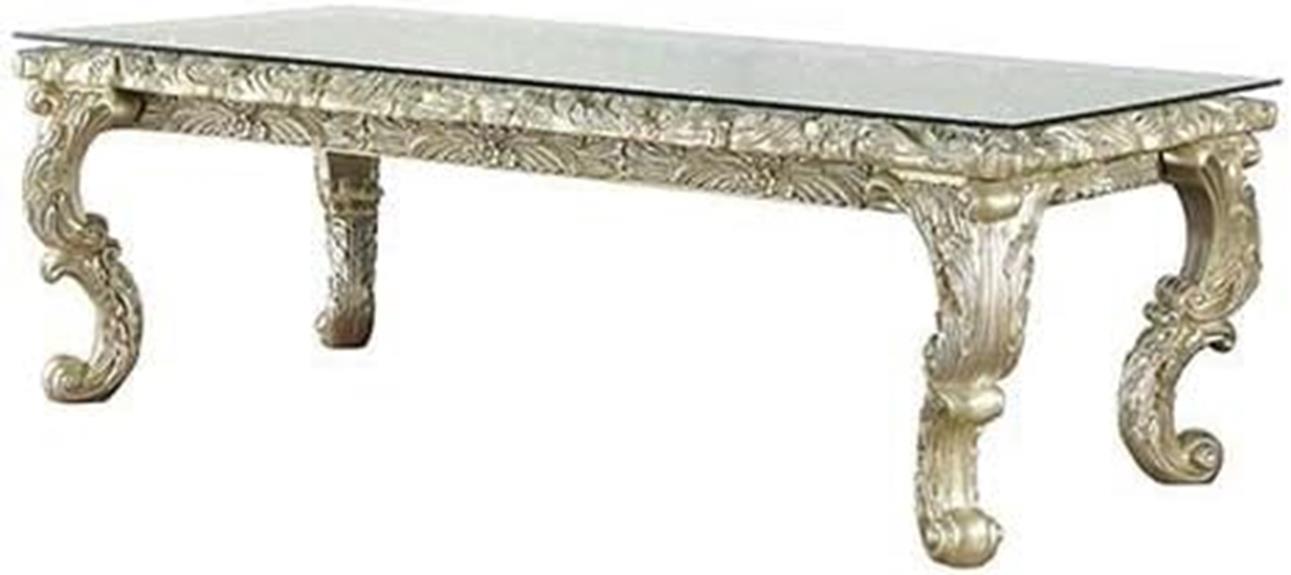I found three fantastic STEM toys that make learning fun and easy for toddlers. Building block sets help boost creativity, problem-solving, and fine motor skills while being safe and colorful. The Kikidex Magnetic Drawing Board encourages early experimentation with shapes and drawing, supporting cognitive growth. Dinosaur STEM toys spark curiosity about science and nature, with safe, engaging designs. Keep exploring to discover how these toys can grow with your child’s interests and skills.
Key Takeaways
- Look for age-appropriate STEM toys that promote hands-on exploration and problem-solving for children aged 1-3 years.
- Choose toys made from non-toxic, durable materials with safety certifications like ASTM or EN71.
- Select colorful, engaging toys that support sensory development and early cognitive skills.
- Prioritize toys with simple, intuitive designs that encourage independent and open-ended play.
- Ensure the toys foster creativity, social interaction, and developmental milestones while being easy to clean and versatile.
Building Block Sets for Kids 3-6 Years Old
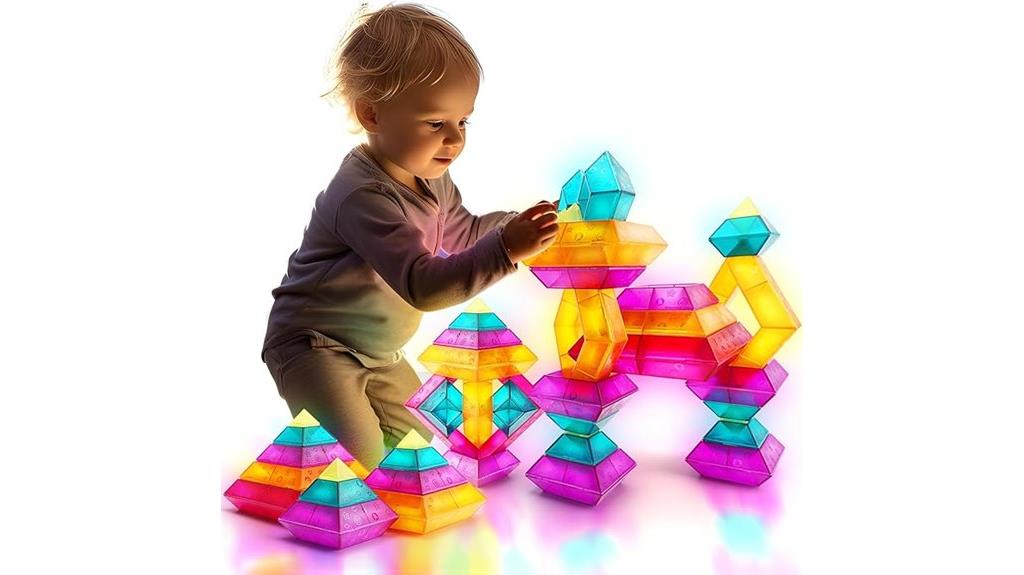
Building block sets for kids aged 3-6 are an excellent choice for young children who are just beginning to explore STEM concepts. I love how these sets include 30 translucent blocks in vibrant colors and various shapes, encouraging hands-on learning. Kids can build anything from towers to imaginative structures, boosting problem-solving and spatial awareness. The included guidebook offers over 60 design ideas, making play both fun and educational. When used on light tables, the blocks glow beautifully, adding a sensory element. Plus, they’re made from safe, durable materials, making them perfect for little hands and long-lasting play.
Best For: young children aged 3-6 who are beginning to explore STEM concepts and enjoy creative building activities.
Pros:
- Includes 30 vibrant, translucent blocks in various shapes and sizes that promote visual curiosity and sensory play.
- Comes with a guidebook featuring over 60 design ideas to inspire creativity and critical thinking.
- Made from high-quality, non-toxic, durable plastic with smooth edges, ensuring safe and long-lasting play.
Cons:
- Limited to a set of 30 blocks, which may require additional sets for more complex constructions.
- Requires a light table to fully experience the glow and sensory effects, which may be an extra purchase.
- May be less suitable for children outside the 3-6 age range due to size and developmental suitability.
Kikidex Magnetic Drawing Board for Toddlers

The Kikidex Magnetic Drawing Board is an excellent STEM toy designed specifically for toddlers aged 1-3, making it perfect for young children who are just beginning to explore their creativity and develop foundational skills. Its sturdy, durable construction with adjustable legs ensures stability during play, while the non-toxic, BPA-free materials guarantee safety. The board’s mess-free design, with a smooth-gliding eraser knob, encourages endless drawing sessions without fuss. Beyond fun, it promotes important skills like hand-eye coordination, color recognition, and early literacy. Whether for a birthday or holiday gift, this board makes learning engaging and easy for little ones.
Best For: young children aged 1-3 years who are beginning to explore creativity and develop foundational skills through engaging, safe, and mess-free play.
Pros:
- Encourages early creativity, artistic expression, and educational development.
- Crafted from durable, non-toxic, BPA-free materials with adjustable legs for stability and comfort.
- Mess-free design with a smooth-gliding eraser knob makes cleanup easy and promotes environmental friendliness.
Cons:
- May be too small for children beyond the toddler age range.
- Limited drawing space could restrict more elaborate creations as kids grow.
- Requires batteries or replacement parts are not included, which may be inconvenient for some users.
Dinosaur STEM Toys for Kids 3-8
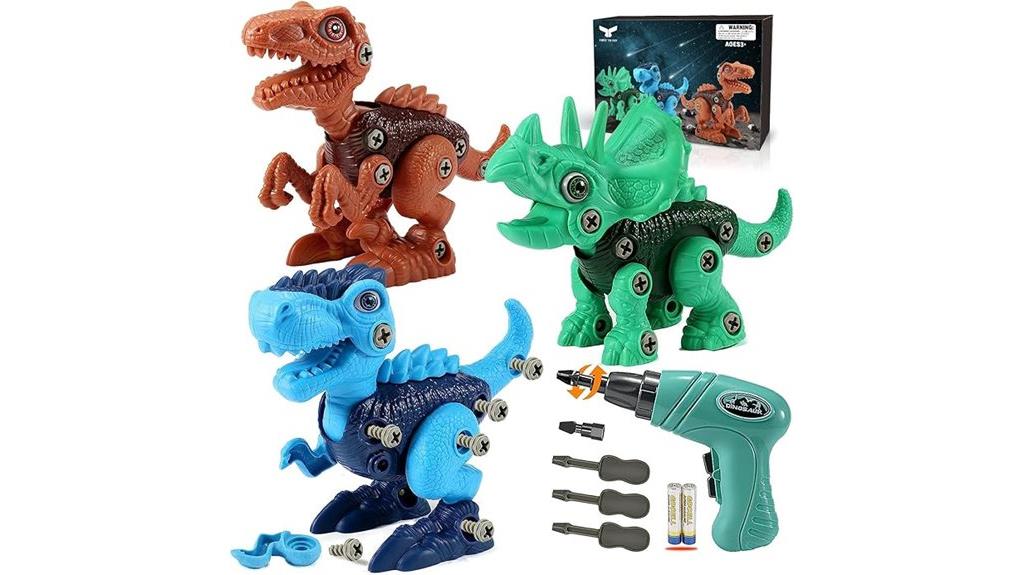
Dinosaur STEM toys designed for kids aged 3 to 8 are perfect for young explorers who love hands-on learning and imaginative play. I find these sets engaging because they include realistic, colorful dinosaurs that kids can assemble and pose, sparking creativity. The set comes with a low-speed electric drill, screwdrivers, and clear instructions, making assembly easy and fun. Kids develop fine motor skills, problem-solving, and basic engineering concepts while enjoying the process. Made of safe, durable, non-toxic materials, these toys are built to last. They make excellent gifts for birthdays or holidays, combining education and entertainment seamlessly.
Best For: children aged 3 to 8 who enjoy hands-on, educational, and imaginative play with durable, safe dinosaur toys.
Pros:
- Promotes fine motor skills, problem-solving, and basic engineering concepts through assembly.
- Made of non-toxic, durable materials with realistic multi-color details that attract children’s attention.
- Includes easy-to-understand instructions and versatile joints for flexible posing, enhancing creative play.
Cons:
- Requires 2 AAA batteries, which are not included, so additional purchase is needed.
- May be too simple for older children outside the 3-8 age range seeking more complex STEM activities.
- Limited to three dinosaur models, which might not satisfy children looking for a larger variety or collection.
Factors to Consider When Choosing STEM Toys for Toddlers

When selecting STEM toys for toddlers, I focus on age appropriateness to ensure the toys match their developmental stage. Safety standards are vital, so I check for non-toxic materials and sturdy construction, while educational value helps me pick toys that promote learning. I also consider material quality and play flexibility to find options that are both durable and adaptable for ongoing fun.
Age Appropriateness
Choosing the right STEM toys for toddlers requires paying close attention to their age and developmental stage. I always check that toys are designed specifically for the 1-3 year age range, ensuring they match their growing skills. It’s important to look for age-appropriate features, like simple assembly for younger toddlers or more challenging tasks for older ones, to prevent frustration. I also verify that toys meet safety standards and don’t contain small parts or choking hazards suitable for their age. Selecting toys that support skills like basic problem-solving and fine motor development helps foster their growth. I always read the recommended age labeling on packaging to make sure the toy’s complexity and safety align with my child’s current abilities, giving me peace of mind and ensuring they learn safely.
Safety Standards
Safety standards are the foundation for selecting STEM toys that are both engaging and secure for toddlers. I always check if the toys meet recognized safety certifications like ASTM F963, EN71, or CPSIA, making certain they’ve been tested for safety. It’s essential that the materials are non-toxic, BPA-free, and lead-free to protect my child’s health. I also look for toys with smooth edges and rounded corners to prevent cuts or injuries during play. Small parts need to be securely attached or appropriately sized to avoid choking hazards, especially for little ones aged 1-3. In conclusion, I make sure the toys are durable enough to withstand rough handling without breaking into dangerous fragments. Prioritizing safety standards gives me peace of mind while my child explores and learns.
Educational Value
To foster a child’s early learning, I focus on STEM toys that actively promote cognitive development through problem-solving, critical thinking, and basic engineering skills. I look for toys that incorporate hands-on activities, which help enhance fine motor skills and spatial awareness by building, assembling, or manipulating parts. Educational value is key, so I choose toys that introduce fundamental concepts like shapes, colors, numbers, and letters in a fun, age-appropriate way. Toys with multiple difficulty levels or open-ended play options encourage ongoing learning and creativity as children grow. Additionally, I guarantee these toys meet safety standards and are made from non-toxic materials, providing a secure environment for exploration and discovery. This balance of engagement and safety makes learning both fun and meaningful.
Material Quality
Since toddlers tend to explore with their hands, guaranteeing the material quality of STEM toys is essential for their safety and durability. I look for toys made from non-toxic, BPA-free materials to prevent any harmful chemical exposure. Durability is also vital—sturdy construction with smooth surfaces and rounded edges helps prevent breakage and minimizes the risk of scratches or injuries. Well-made toys should withstand repeated use without losing integrity, so I prioritize materials resistant to wear and tear. Certifications like CPC or ASTM provide reassurance that the toy meets established safety standards for children’s products. Ultimately, choosing high-quality materials ensures that playtime is both safe and long-lasting, giving peace of mind while fostering my child’s curiosity and learning.
Play Flexibility
Flexible STEM toys are essential because they let toddlers explore and create in multiple ways, keeping play engaging and educational. These toys support open-ended play, encouraging kids to experiment with different configurations and ideas. When a toy offers various assembly or building options, it promotes creativity and adapts to a child’s developing skills. Play flexibility also helps build problem-solving and critical thinking skills, as toddlers try new ways to use the toys. Versatile STEM toys are perfect for collaborative activities, fostering social skills and teamwork. Choosing toys with adaptable features ensures children stay interested over time, preventing boredom as their interests evolve. Overall, flexible toys grow with your child, making learning both fun and long-lasting.
Visual Appeal
When selecting STEM toys for toddlers, visual appeal plays a key role in capturing their interest and encouraging exploration. Bright, vibrant colors and clear shapes help stimulate their senses and attract attention. Translucent or reflective materials add mesmerizing effects, sparking curiosity and inviting closer examination. Simple, high-contrast designs improve shape and color recognition, making it easier for toddlers to differentiate and understand. Engaging patterns, textures, and inviting visual cues can motivate them to explore further. However, it’s essential to balance visual complexity with simplicity to avoid overwhelming young children. Well-designed STEM toys should be visually stimulating yet straightforward enough to support focused play. When visual appeal is thoughtfully considered, it enhances a toddler’s learning experience and keeps them eager to discover.
Ease of Use
Choosing STEM toys that are easy for toddlers to use involves focusing on simple, intuitive controls and straightforward assembly. Toys with minimal parts and clear instructions help prevent frustration and encourage independent play. Large, non-slip buttons or handles make it easier for small hands to grip and manipulate, boosting confidence during play. Incorporating visual cues or color coding guides children naturally through activities without needing constant adult help. Additionally, safety features like rounded edges and non-toxic materials ensure the toy is easy and safe to handle. The goal is to select toys that promote exploration without overwhelming the child. When a toy is simple to operate and safe to use, it fosters independence and makes learning a fun, smooth experience for toddlers.
Gift Compatibility
Selecting the right STEM toy as a gift involves ensuring it matches the child’s age and developmental stage. For example, a magnetic drawing board suits 1-3-year-olds, while construction sets are better for ages 3-8. It’s also important to take into account the child’s interests, like dinosaurs or building blocks, to keep them engaged. I always check for safety certifications and non-toxic materials, so I know the toy is safe for young children. Versatility matters too—opportunities for open-ended or guided play help support different learning styles. Finally, I look for durable toys that are easy to clean, ensuring they withstand repeated use and remain a lasting, thoughtful gift. Choosing wisely makes a real difference in fostering a child’s curiosity and development.
Frequently Asked Questions
Are STEM Toys Safe for All Toddlers?
Yes, STEM toys are generally safe for all toddlers when chosen carefully. I always check for age-appropriate labels and verify toys are free from small parts that could pose choking hazards. I also look for non-toxic materials and sturdy construction. It’s important to supervise playtime, especially with younger children, to keep them safe while they explore and learn. When in doubt, I consult reviews and recommendations from trusted sources.
How Do STEM Toys Support Early Childhood Development?
STEM toys ignite a toddler’s curiosity like a fireworks display lighting up the night sky. I’ve seen how they boost problem-solving, foster creativity, and develop fine motor skills. These toys introduce concepts like science, technology, engineering, and math in a fun, hands-on way. By engaging children actively, they lay a sturdy foundation for future learning, making complex ideas simple and exciting for little minds.
What Age Is Best for Introducing STEM Toys?
I believe the best age to introduce STEM toys is around age 2 or 3. At this stage, toddlers start exploring their environment and developing basic motor skills. Introducing age-appropriate, simple STEM toys helps spark curiosity and supports early learning. I recommend choosing toys that are safe, engaging, and designed for little hands, so your child can enjoy discovering and learning through play.
Can STEM Toys Be Used for Group Learning?
Yes, STEM toys are great for group learning. I’ve seen kids collaborate, share ideas, and solve problems together using these toys. They encourage teamwork and communication, making learning more engaging and social. When children work in groups, they develop important skills like cooperation and critical thinking. So, I definitely recommend using STEM toys in group settings to foster both fun and educational growth for toddlers.
How to Encourage Creativity With STEM Toys?
To encourage creativity with STEM toys, I suggest giving your child open-ended options that spark imagination. I often let them experiment freely, combining different pieces or trying out new ideas without strict instructions. Asking open-ended questions like “What can you build?” or “How does this work?” also stimulates their thinking. Most importantly, I praise their efforts and unique ideas, which boosts their confidence and fuels their creative exploration.
Conclusion
Ultimately, choosing the right STEM toy can spark a child’s curiosity and love for learning. Remember, “Give a child a fish, and you feed them for a day; teach a child to fish, and you feed them for a lifetime.” By selecting engaging, age-appropriate toys, you’re helping build a strong foundation for their future. So trust your instincts, and watch your little one thrive as they explore, create, and learn with joy.

